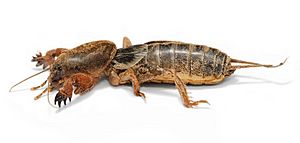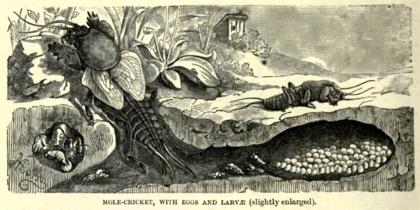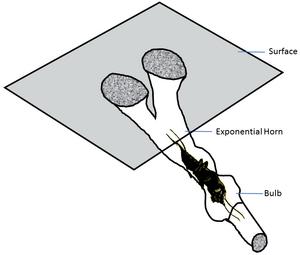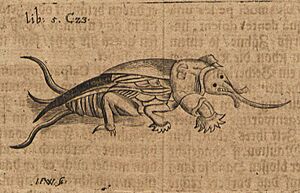Mole cricket facts for kids
Quick facts for kids Mole cricket |
|
|---|---|
 |
|
| Gryllotalpa brachyptera | |
| Scientific classification |
|
| Kingdom: | Animalia |
| Phylum: | Arthropoda |
| Class: | Insecta |
| Order: | Orthoptera |
| Suborder: | Ensifera |
| Infraorder: | Gryllidea |
| Superfamily: | Gryllotalpoidea |
| Family: | Gryllotalpidae Saussure, 1870 |
 |
|
| Distribution of Gryllotalpa, Scapteriscus, Neocurtilla | |
| Synonyms | |
|
|
Mole crickets are amazing insects that belong to the family Gryllotalpidae. They are related to grasshoppers and other crickets. These unique creatures have bodies shaped like cylinders, perfect for living underground.
Adult mole crickets are usually about 3 to 5 centimeters long. They have tiny eyes and strong front legs that look like shovels. These special legs help them dig tunnels in the soil. You can find mole crickets in many parts of the world. Sometimes, when they move to new places, they can become a problem for farmers.
Mole crickets go through three stages in their lives: egg, nymph, and adult. Most of their time is spent hidden underground. However, adult mole crickets have wings and can fly. They use their wings to find new places during the breeding season.
Their diet can be different depending on the species. Some mole crickets are herbivores, meaning they mostly eat plant roots. Others are omnivores, eating both plants and small creatures like worms. A few species are even predators, hunting other insects.
Male mole crickets are known for their incredibly loud songs. They sing from special burrows that act like a megaphone, making their calls even louder. This song is a clear, chirping sound. It helps them attract females, either for mating or to show them good places to lay eggs.
In some cultures, mole crickets are seen as special. In Zambia, people believe they bring good luck. In Latin America, some say they can predict rain. But in places like Florida, where they are not native, some types of mole crickets are considered pests. People use different methods to control them there. In several Asian countries, like Vietnam and Thailand, Gryllotalpa mole crickets are even eaten as food!
Contents
What Do Mole Crickets Look Like?
Mole crickets come in different sizes and appearances. Most adult mole crickets are about 3.2 to 3.5 centimeters long. Their bodies are shaped like cylinders and covered with fine, soft hairs. This helps them move easily underground.
Their heads, front legs, and the first part of their chest are very hard. But their abdomen, or back part, is quite soft. They have two thin antennae on their heads and a pair of small, shiny eyes.
Mole crickets have two pairs of wings that fold flat over their bodies. Their front wings are usually short and rounded. The back wings are thin and can reach or go past the end of their body. However, some species have small back wings and cannot fly.
Their front legs are flat and wide, perfect for digging. Their back legs look a bit like those of a regular cricket. But instead of jumping, mole crickets use these legs to push soil. They rarely jump and are not very good at it. Young mole crickets, called nymphs, look like smaller versions of the adults. They don't have wings or reproductive parts yet. Their wing pads grow bigger after each time they shed their skin.

How Do Mole Crickets Behave?
Most adult mole crickets can fly well, though they might not be very graceful. Males don't fly very often. Females usually start flying shortly after sunset. They are drawn to areas where males are singing. This happens for about an hour after the sun goes down. Females might fly to mate or to find a good place to lay their eggs. The number of singing males nearby can show them if a habitat is suitable.
Life Cycle and Reproduction
Mole crickets go through a process called incomplete metamorphosis. This means that when their nymphs hatch from eggs, they look more and more like the adult form as they grow. They shed their skin up to 10 times as they get bigger.
After mating, a female mole cricket might wait one to two weeks before laying eggs. She digs a tunnel about 30 centimeters deep into the soil. Sometimes, in a lab, they have been seen digging as deep as 72 centimeters! She then lays a batch of 25 to 60 eggs.
Some female mole crickets, like those in the Neoscapteriscus group, seal the entrance to their egg chamber and leave. But females of Gryllotalpa and Neocurtilla species stay near their eggs in a nearby chamber to care for them. A female might lay several batches of eggs over a few months. Eggs need moist ground to hatch. Many young mole crickets die if the soil is too dry. The eggs hatch in a few weeks. As they grow, the nymphs eat a lot of plant material, both underground and on the surface.
Adult mole crickets can travel quite far during the breeding season, sometimes up to 8 kilometers. Mole crickets are active for most of the year. In colder places, they spend winter as nymphs or adults, becoming active again in the spring.
Burrowing Habits
Mole crickets live almost entirely underground. They dig different types of tunnels for various important activities. These include finding food, escaping from predators, attracting mates (by singing), mating, and raising their young.
Their main tunnels are used for feeding and escaping danger. They can dig themselves underground very quickly. They can also move at high speed through their tunnels, both forwards and backwards. To dig, they push soil to the sides using their powerful, shovel-like front legs. These legs are wide, flat, and have teeth-like edges. They are also very hard and dark.
Male mole crickets dig special tunnels where they sing to attract mates. Mating happens inside the male's burrow. The male might make a tunnel wider for the female to join him. In some species, they mate tail-to-tail. Females lay their eggs either in their regular tunnels or in special egg chambers. Some species seal these chambers, while others do not.
The Mole Cricket Song
Male mole crickets sing by rubbing their wings together, a process called stridulating. They always do this underground. For example, the Gryllotalpa gryllotalpa mole cricket produces a clear sound at 3.5 kHz. This sound is so loud it can make the ground vibrate 20 centimeters around the burrow! Each species has its own unique song.
The burrow itself is shaped like a double horn with a bulb, which helps the sound travel far. The male positions himself head-down in the bulb, with his tail near a fork in the tunnel. This special burrow helps the sound become very loud. A male will use the same burrow for at least a week.
Mole crickets make sound by scraping the back edge of their left front wing against the bottom of their right front wing. The right wing has a series of teeth. When the left wing scrapes backwards, it catches on these teeth, making both wings vibrate and produce sound. The sound is like a pure tone that is modulated into regular chirps.
Some mole crickets, like G. vineae, can produce an incredibly loud song. It starts about half an hour after sunset and continues for an hour. This song can be heard up to 600 meters away! At 1 meter from the burrow, the sound can be as loud as 88 decibels. At the burrow's opening, it can reach around 115 decibels. This is because the burrow is shaped to make the sound travel very efficiently. Mole crickets are the only insects known to build a special structure just for making sound.
The louder a male's song, the more attractive he is to females. This is because a loud song often means the male is larger and lives in a good habitat. The loudest males can attract many females in one evening. Scientists can even use recordings of male songs to trap large numbers of females.
What Do Mole Crickets Eat?
Mole crickets have different diets. Some, like the tawny mole cricket, are herbivores and eat only plants. Others are omnivores, eating larvae, worms, roots, and grasses. Still others, like the southern mole cricket, are mainly predators, hunting other insects. At night, they leave their burrows to find leaves and stems. They drag these underground to eat them. They also eat roots while underground.
Who Eats Mole Crickets?
Many animals hunt mole crickets. These include birds, toads, and mammals that eat insects. Other predators are underground assassin bugs, wolf spiders, and various beetles.
There are also tiny creatures that attack mole crickets. A tiny worm called Steinernema scapterisci from South America can kill Neoscapteriscus mole crickets. It does this by putting bacteria into their bodies, causing a big infection. Another type of worm, Steinernema neocurtillae, attacks native mole crickets in Florida.
Parasitoid wasps from the genus Larra also attack mole crickets. The female wasp lays an egg on the outside of the mole cricket. The wasp larva then grows by feeding on the mole cricket. A special fly called Ormia depleta is also a parasite of Neoscapteriscus mole crickets. The female fly is attracted to the male mole cricket's song. She then lays her larvae on any mole cricket she finds.
Some bombardier beetles are also predators of mole cricket eggs. In China and Japan, Stenaptinus jessoensis eats the eggs. In South America, Pheropsophus aequinoctialis does the same. The adult beetle lays eggs near mole cricket burrows. The beetle larvae then find the egg chamber and eat the mole cricket eggs.
Fungal diseases can also harm mole cricket populations, especially during warm winters. The fungus Beauveria bassiana can infect adult mole crickets.
Mole crickets try to avoid predators by living underground. If they are disturbed on the surface, they dig very fast to get away. As a last defense, if caught, they can squirt a bad-smelling brown liquid from their bodies. They can also bite.
Where Do Mole Crickets Live?
Mole crickets are quite common, but you rarely see them. This is because they are active at night and spend almost all their lives underground in long tunnel systems. They live in farm fields and grassy areas.
You can find mole crickets on every continent except Antarctica. By 2014, scientists had described 107 different species. More species are likely to be found, especially in Asia. Some species, like Neoscapteriscus didactylus, are considered pests. This species came from South America and has spread to the West Indies and Australia. Gryllotalpa africana is a major pest in South Africa. Other Gryllotalpa species are found widely in Europe, Asia, and Australia. The G. gryllotalpa species used to live in Britain but might now be extinct there, though it still lives in the Channel Islands.
Controlling Invasive Mole Crickets
Invasive species are animals or plants that cause harm when they are introduced to a new area. Sometimes, people try to control them using biological control. This means using natural enemies to reduce their numbers.
One of the first invasive mole cricket species found was Neoscapteriscus didactylus. It came from South America and was reported as a pest in the West Indies as early as 1837. By 1900, it was a big problem for farms in Puerto Rico. It likely spread slowly from South America, island by island. In Puerto Rico, a biological control program successfully introduced a parasitoid wasp called Larra bicolor from Brazil. By 2001, N. didactylus was only a pest in irrigated farms and lawns in Puerto Rico.
Later, this same species was found as a pest in Australia, probably arriving by ship or plane. Another invasive species was found in Hawaii in the late 1800s. It was first thought to be Gryllotalpa africana but was later identified as Gryllotalpa krishnani. It attacked sugarcane. In 1925, a wasp called Larra polita was brought from the Philippines to control it, and it seemed to work.
Later, three South American Neoscapteriscus species (N. abbreviatus, N. vicinus, and N. borellii) arrived in Georgia, USA. They likely came in ship ballast, which is material used to balance ships. These mole crickets caused big problems for many years as they spread across the Southeastern USA. They damaged pastures, lawns, playing fields, and vegetable crops.
For a long time, a chemical called chlordane was used to control them. But when it was banned in the 1970s, farmers needed new ways to fight the pests. A research program was started in Florida in 1978 to help. By 2006, the program announced great success: a 95% reduction in mole cricket numbers in northern Florida! The biological control agents were spreading across Florida.
One of the control agents was the wasp Larra bicolor. A type of this wasp from Bolivia was brought to northern Florida and spread widely, helping to control the mole crickets. These wasps need certain flowers for nectar to survive.
Another control agent was the fly Ormia depleta. Female flies are attracted to the male mole cricket's song. Scientists learned how to raise these flies and released many of them in Florida, mainly on golf courses, from 1989 to 1991. The flies established populations and spread, helping to control the mole crickets.
The third biological control agent was a tiny worm called Steinernema scapterisci from South America. Small tests showed it could survive for years in Florida's sandy soils. This worm was even patented as a biopesticide. Large-scale trials on farms and golf courses successfully established populations that spread.
Mole Crickets as Pests

The main damage caused by mole crickets comes from their digging. As they tunnel through the top few centimeters of soil, they push the ground up in small ridges. This makes the surface soil dry out faster. It also disturbs seeds trying to sprout and damages the delicate roots of young plants. They also harm lawns and pastures by eating the roots of grasses. This makes the plants weak and easily damaged.
In their native homes, mole crickets have natural enemies that keep their numbers in check. But when they are accidentally brought to new parts of the world, they often don't have these enemies. This allows their populations to grow very large. In Florida, from the 1940s to the 1980s, mole crickets were a "serious problem." However, their numbers have greatly decreased since then, thanks to control efforts.
One way to fight these pests is biological pest control, using natural enemies like the parasitoidal wasp Larra bicolor. Another successful method is using the parasitic worm Steinernema scapterisci. When this worm is put in strips across grasslands, it spreads throughout the area in a few months. It not only controls the mole crickets but also stays in the soil, ready to fight future generations.
Mole Crickets in Human Culture
Folklore and Beliefs
In Zambia, people believe that seeing a Gryllotalpa africana mole cricket brings good luck.
In Latin America, some say that Scapteriscus and Neocurtilla mole crickets can predict rain when they dig into the ground.
In Japan, in the past, mole crickets were sometimes linked to old beliefs about creatures that would report a person's sins to heaven.
Mole Crickets as Food
Gryllotalpa mole crickets are sometimes eaten as food in West Java and Vietnam. In Thailand, mole crickets are a popular food, especially in the Isan region. They are usually fried and eaten with sticky rice.
In the Philippines, mole crickets are a special dish called camaro in the province of Pampanga. They are a tourist attraction there. They are also served in parts of Northern Luzon.
See also
 In Spanish: Grillotálpidos para niños
In Spanish: Grillotálpidos para niños





